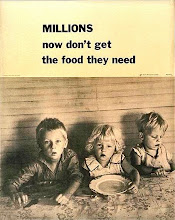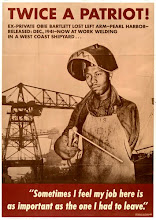Ben Franklin worried about Germans. Hordes of white newcomers were ghettoized in the mid-19th century (they were Irish). The process would be repeated with Italians. Eastern Europeans were considered both foreign and inferior. Bigots were convinced that Cubans were a pox on a blighted city named Miami. Instead, they saved it. Vietnamese and Laotian immigrants provided a nativist crisis in the 1970s & 1980s. Said crisis hasn't been heard from in the past quarter-century. Which brings us to the current crop of short immigrants with large families and little formal education, who hail from depressed economies with high unemployment, speak a foreign language and worship a"foreign power".The invective wouldn't be so pathetic if it weren't so damn old.
Worst of all, the "modern" Right pays no attention to our record of home-grown poverty and internal mass migration. To this day, skin color provides no immunity from poverty in America. Not so long ago, poverty was simply color-blind. America was largely a "developing nation" well into the 20th century. Impoverished white people moved from Oklahoma to California for exactly the same reasons that impoverished brown people cross our southern borders today.
This post presents nine photos borrowed from Shorpy. Eight were taken by Dorothea Lange, who worked for the Farm Security Administration. Her work is a color-blind chronicle of misery, poverty and despair.
Click any image in this post to view full size
August 17, 1936. Blythe, California. "Drought refugees from Oklahoma camping by the roadside. They hope to work in the cotton fields. There are seven in family. The official at the border inspection service said that on this day, 23 carloads and truckloads of migrant families out of the drought counties of Oklahoma and Arkansas had passed through from Arizona entering California." Dorothea Lange for the Resettlement Administration.August 1936. "People living in miserable poverty. Elm Grove, Oklahoma County, Oklahoma." Dorothea Lange for the Farm Security Administration.
November 1936. "Daughter of migrant Tennessee coal miner. Living in American River camp near Sacramento, California." Dorothea Lange for the Farm Security Administration.
February 1939. Calipatria, Imperial Valley. Farm Security Administration emergency migratory labor camp. Daughter of ex-tenant farmers on thirds and fourths in cotton. Had fifty dollars when set out. Went to Phoenix, picked cotton, pulled bolls, made eighty cents a day. Stayed until school closed. Went to Idaho, picked peas until August. Left McCall with forty dollars "in hand." Went to Cedar City and Parowan, Utah, a distance of 700 miles. Picked peas through September. Went to Hollister, California. Picked peas through October. Left Hollister for Calipatria for early peas which froze. Now receiving Farm Security Administration food grant and waiting for work to begin. "Back in Oklahoma, we are sinking. You work your head off for a crop and then see it burn up. You live in debts that you can never get out of. This isn't a good life, but I say that it's a better life than it was." Photo and caption by Dorothea Lange.
June 1938. Nettie Featherston, laborer's wife with three children near Childress, Texas. "I just prayed and prayed and prayed all the time that God would take care of us and not let my children starve." Photo and caption by Dorothea Lange.
Oregon, August 1939. "Unemployed lumber worker goes with his wife to the bean harvest. Note Social Security number tattooed on his arm." (Shorpy scholarship/detective work: a public records search shows that 535-07-5248 belonged to Thomas Cave, born July 1912, died in 1980 in Portland. Which would make him 27 years old when this picture was taken.) Dorothea Lange.
"Destitute pea pickers living in tent in migrant camp. Mother of seven children. Age thirty-two." Nipomo, California. February 1936. Photograph by Dorothea Lange. The anonymous subject of this famous Depression-era portrait known as "Migrant Mother" came forward in the late 1970s and was revealed to be Florence Owens Thompson . She died in 1983.
August 1939. Agricultural migrants. "Family who traveled by freight train. Toppenish, Washington. Yakima Valley." Dorothea Lange for the Farm Security Administration.
October 1938. Farm wife and baby waiting in the car while her husband attends the auction. Oskaloosa, Kansas. Photograph by John Vachon.
****************************
All photos & captions sourced from Shorpy.
****************************
Wikipedia has a decent post on the Farm Security Administration. The Wikipedia post has links to FSA photographers. Lange is probably the best known. The FSA ran an extensive photography program which can be accessed at the Library of Congress.





























+breed+danger+6x8.jpg)











+5x7.jpg)


No comments:
Post a Comment